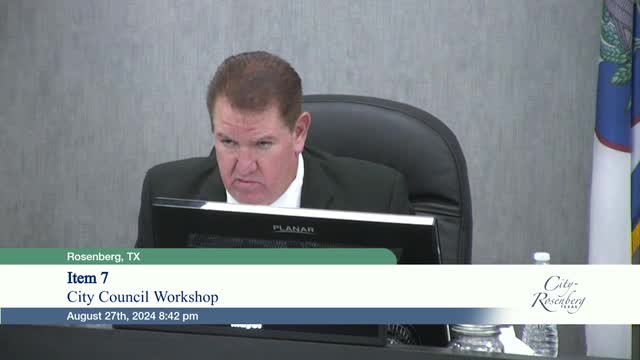Council debates no kill policy amid rising animal shelter concerns
August 27, 2024 | Rosenberg, Fort Bend County, Texas
This article was created by AI summarizing key points discussed. AI makes mistakes, so for full details and context, please refer to the video of the full meeting. Please report any errors so we can fix them. Report an error »

During a recent government meeting, council members engaged in a robust discussion regarding the local animal shelter's \"no kill\" policy and its implications for the community. The conversation highlighted the complexities surrounding the definition of \"no kill,\" with council members emphasizing that it does not equate to a complete absence of euthanasia. Instead, to be classified as \"no kill,\" organizations must maintain a placement rate of at least 90%.
The director of the animal shelter confirmed that while the shelter had dipped below this threshold during a recent outbreak, it has consistently maintained a rate above 90% since his appointment. This statistic was presented to counter claims made by community members questioning the shelter's adherence to the no kill philosophy.
Budgetary concerns were also addressed, with the council approving an increase in funding for the Trap-Neuter-Return (TNR) program from $15,000 to $25,000 for the upcoming fiscal year. This decision was made in response to ongoing discussions about the shelter's operational needs and community feedback.
Additionally, the council discussed the importance of transparency regarding the shelter's policies, agreeing to ensure that the no kill policy is prominently displayed on the shelter's website. This move aims to alleviate public concerns and clarify the shelter's commitment to animal welfare.
The meeting also touched on volunteer engagement at the shelter, with the director clarifying that volunteers are not being rejected but must pass background checks to participate. The council expressed a desire for improved communication regarding volunteer activities and contributions.
Overall, the meeting underscored the council's commitment to animal welfare, transparency, and community engagement, as they navigate the challenges of maintaining a no kill status while addressing budgetary and operational needs.
The director of the animal shelter confirmed that while the shelter had dipped below this threshold during a recent outbreak, it has consistently maintained a rate above 90% since his appointment. This statistic was presented to counter claims made by community members questioning the shelter's adherence to the no kill philosophy.
Budgetary concerns were also addressed, with the council approving an increase in funding for the Trap-Neuter-Return (TNR) program from $15,000 to $25,000 for the upcoming fiscal year. This decision was made in response to ongoing discussions about the shelter's operational needs and community feedback.
Additionally, the council discussed the importance of transparency regarding the shelter's policies, agreeing to ensure that the no kill policy is prominently displayed on the shelter's website. This move aims to alleviate public concerns and clarify the shelter's commitment to animal welfare.
The meeting also touched on volunteer engagement at the shelter, with the director clarifying that volunteers are not being rejected but must pass background checks to participate. The council expressed a desire for improved communication regarding volunteer activities and contributions.
Overall, the meeting underscored the council's commitment to animal welfare, transparency, and community engagement, as they navigate the challenges of maintaining a no kill status while addressing budgetary and operational needs.
View full meeting
This article is based on a recent meeting—watch the full video and explore the complete transcript for deeper insights into the discussion.
View full meeting
